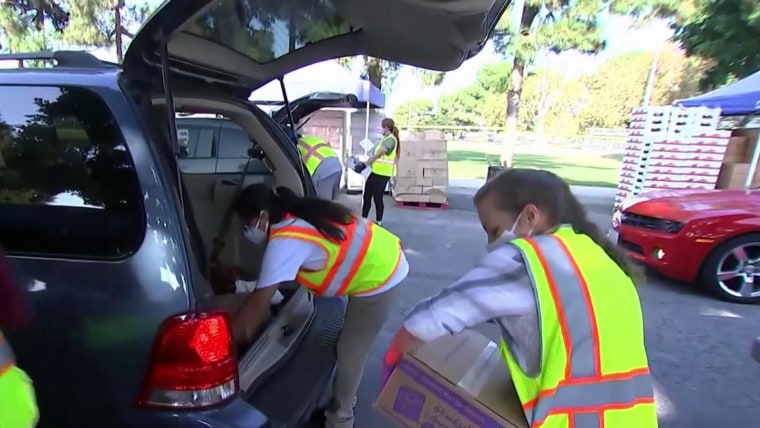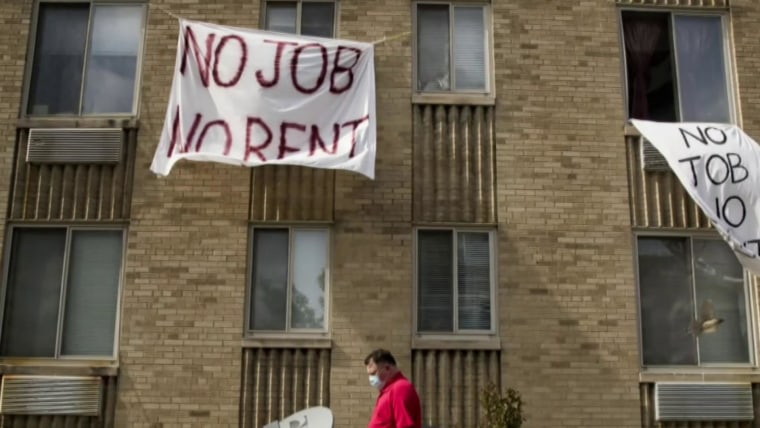
Six months into the pandemic, some laid-off workers find themselves waiting weeks or even months to receive their unemployment benefits. States blame antiquated technology and say their staffers can’t keep up with the continued surge of claims, while worker advocates say these are just excuses for mismanagement and a failure to prioritize funding for upgrades. As this plays out, an untold number of families are hanging on by a financial thread.
“I'm living with my mother now, out of necessity,” said Adia Romaine-Figueroa, a Sacramento-area veterinary assistant who lost her job in April and inexplicably stopped receiving unemployment payments at the beginning of May, she said. “I have a balance of $10,000, of which I've received $2,000,” Romaine-Figueroa said she has spent hours trying to reach someone — anyone — at the state’s Economic Development Department to no avail.
Half a country away, Indiana hotel worker David Kruszewski describes a Kafka-esque loop of being told he qualified for benefits, only to have his claims denied, for more than two months after he stopped working to care for his five kids after his wife landed a new full-time job. “Funny how fast they deny a claim, but it takes months to be accepted,” he said. “It’s been a horrible struggle,” that has entailed hours on hold, and no resolution in sight.
Americans turning to food banks amid soaring unemployment rates
SEPT. 4, 202005:04Kruszewski said the ordeal has taken a heavy financial and mental toll.
“They tell me to just wait. My bills are all behind, my pantry is empty, my pockets and savings are dry [and] we’re about to lose internet — so the kids won't even be able to do their online schooling,” he said. “I'm afraid we’re going to lose our home and there's nothing I can do about it. The funds they are holding would pay our bills, fill our bellies, and supply my children with the tools they need for their education.”
"The funds they are holding would pay our bills, fill our bellies, and supply my children with the tools they need for their education.”
Tara F. Magee, who lives in Pinellas County, Florida, sold vacation packages and cruises before the pandemic. She went for 16 weeks without getting an unemployment payment.
“My mother is retired and collects Social Security and we own the house, thank God. I don't know how people without anyone are doing,” she told NBC News. Magee estimated that the state owed her some $10,000 in back payments at one point.
“Paying eligible Floridians the benefits they are owed continues to be our number one priority,” Florida Department of Economic Opportunity press secretary Paige Landrum said in an emailed statement.
But the data suggests that many people are falling through the cracks. An analysis of the first four months of pandemic unemployment by the Century Foundation found that only about 57 percent of claims had been paid as of the end of July.
“It’s taking them seven weeks on average, instead of three weeks, and those are just among the decided cases,” said Andrew Stettner, a senior fellow at the Century Foundation. “We have to hold states' feet to the fire to make sure they fulfill those rights.”
There has been some improvement since then, but not much. According to a Bloomberg analysis of a U.S. Census Bureau survey conducted last month, roughly one in four — about 12 million — people who said they applied for unemployment benefits reported not receiving that money.
“Our problem is more the system being overwhelmed by the huge number of claimants, but also there are a lot of systemic problems,” said Anne Paxton, attorney and policy director at the Unemployment Law Project in Seattle, a worker advocacy group that has filed a lawsuit over what it calls “unacceptable” delays processing unemployment benefit claims in the state of Washington. “They’ve never caught up and there are still tens of thousands of people whose claims have been pending for weeks,” she said.
“We get emails from people who have had their cars repossessed or had to move in with parents,” Paxton said. “They talk about being forced out of their homes, having to relocate, having their bank accounts frozen for weeks… I don’t know how so many people are getting by. What we hear from them are really dire circumstances,” she said.
“There's really no due process — you just get stuck in a bureaucratic netherworld,” Stettner said.
Many of the reasons people’s unemployment claims get stuck in limbo would seem to be simple: A typo in a name, a discrepancy between the hours submitted by the worker and the employer, a layoff miscategorized as quitting — all of which then go through an adjudication process that entails an employee verifying every individual applicant’s eligibility. But the pandemic’s deluge of jobless claims swamped the departments tasked with reconciling those mistakes.
Millions at risk of losing homes as eviction ban expires
AUG. 3, 202004:02Experts in unemployment insurance say that even before the pandemic, the system was a rickety patchwork — one into which states had to integrate the Pandemic Unemployment Assistance and Pandemic Emergency Unemployment Compensation programs, adding another layer of complexity.
Annelies Goger, a fellow at Metropolitan Policy Program at the Brookings Institution, said part of the backlog was due to the way the programs were designed, then undermined by budget cuts. “We’ve spent about 35 years scaling back unemployment systems and making it harder for people to get the benefits,” she said.
“All states are trying to improve the efficiency, but all states have competing demands for financing and the federal money going to states has not been inadequate,” said Christopher O'Leary, senior economist at the W.E. Upjohn Institute for Employment Research.
“A lot of the incentive these programs are built on is making sure that nobody gets benefits that shouldn’t qualify. There is a real priority not on getting benefits out quickly but on getting it out accurately,” Goger said.
There is a real priority not on getting benefits out quickly — but on getting them out accurately.
In ordinary times, this can create headaches for filers, but in a pandemic, Goger said those administrative tasks piled up fast. “That’s a big bottleneck.”
In some states, O’Leary said the system is designed to thwart rather than help applicants. “Some states regard unemployment insurance as an important pillar of the labor market, others look at it as a cost of doing business,” he said. Since unemployment benefits are jointly funded by employers and employees, elected officials in some states prioritize a lower-tax business environment, an incentive that comes at the expense of more generous benefits for workers.
This ideological divide creates a remarkably inefficient framework for delivering assistance to jobless workers.
“It’s a very decentralized system and every state has its own separate system,” Goger said, which means each individual state has to essentially reinvent the wheel when they invest in technological upgrades. “You can’t get any economies of scale in modernizing those systems across more than one state very easily,” she said.
O’Leary said a well-run unemployment system is an investment in the local labor market because it allows an applicant to seek out a new job that matches their skill set rather than settle for a job for which they are ill-suited out of desperation. “If you have to take the first job that comes along, the economy might not be producing at a higher rate,” he said.
“These are historic times creating an unprecedented demand for unemployment benefits,” a spokesperson for the California Economic Development Department said in an emailed statement, saying that most eligible applicants get payments within three weeks. “Our agency is working hard to address the unacceptable backlog of unpaid unemployment insurance claims by no later than the end of September,” the Department said.
To workers who have been waiting for months on long-promised payments, these promises come too little, too late.
“It's just very confusing and frustrating that the system is this bad when California is supposed to be the technological leader of the country,” Romaine-Figueroa said. “How can Silicon Valley make money hand over fist, yet... their websites don't work and their computers are decades old.”


